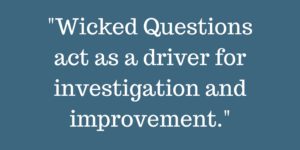 A wicked question is one where it is so complex that there is no final answer. We work to the best solution we can, which works for some period of time, then we have to revisit it again as conditions change. (The wicked question keeps repeating, sometimes reminding us of a bad penny – that keeps showing up at inopportune times!)
A wicked question is one where it is so complex that there is no final answer. We work to the best solution we can, which works for some period of time, then we have to revisit it again as conditions change. (The wicked question keeps repeating, sometimes reminding us of a bad penny – that keeps showing up at inopportune times!)
A wicked question requires that we articulate the paradoxical challenges that a group must confront to succeed. Here are some quick examples:
- How can we dramatically improve safety and quality while drastically reducing costs?
- How do we work together as a team when we all have competing agendas?
- How can we commit ourselves to be accountable to measuring results while being open to the possibility that we may not be measuring the right outcomes?
Let me pose this wicked question – one that many of you, as Leaders, may be facing: The question of how to deal with marijuana in the work place, treat all stakeholders fairly, reduce injury rates, better protect the environment and our neighbors, honor the responsibility of our employers for providing a safe workplace, meet OSHA requirements and improve the competitive strength of our businesses? – This is a wicked question!
There is no doubt that marijuana has an impact on our brains. But how much, how long does it last, how much does it impact our ability to think clearly, react appropriately to situations as they change and work safely for ourselves and those around us?
All the stakeholders have ideas about what they see as fair. How do we resolve all the competing demands? We all need safe workplaces and strong, competitive businesses. We need to protect the environment and our neighbors. Those who drive and travel also need to be sharp and alert.
Some Ideas to Consider
 We need to approach this from the whole systems perspective since everything is connected to everything else. Experience shows that if we try to just fix one part of the system or another, we will wind up making other parts worse.
We need to approach this from the whole systems perspective since everything is connected to everything else. Experience shows that if we try to just fix one part of the system or another, we will wind up making other parts worse.
We need to work together in a way that will bring all our strengths and energy to developing the best solutions we can and not bring the sort of conflict we see in Washington into our workplaces. We need to search for the truth and the best solutions as we can.
Developing some agreed-upon basis for the work is critical. For me the mantra was, “I don’t have a right to make my living where it is okay for you to get hurt. We have to make money as well so let’s figure it out and do it.” The key word in this statement is “okay”. It does not mean that bad things may happen. It does mean that we have the courage and determination to relentlessly work together in the pursuit of excellence together – so that bad things will likely not happen.
Having developed our foundation, we next need to bring the people together in tough, focused, serious conversations to best address all the various issues, fairness and demands – developing the best solutions we can for our particular situation. This highly complex, wicked problem needs us all to work with a deep respect for each other, listening, learning and caring.
Simple training programs are insufficient. Edicts from OSHA or top management tend to address only a part of the problem. We all need to work together, engaging in deep conversations with respect and consideration.
A Complexity Tool
A highly effective tool to use to have the critical conversations is the Process Enneagram©, which enables everyone to see the whole, the parts and the interaction of the parts. Using this we can develop a living strategic plan which you can modify as you go forward and conditions change, around the wicked problem and all its tentacles. You can learn more about this tool at RNKnowlesAssociates.com. Please give us a call at 716-622-6467 if you want to learn more about the effectiveness of this way of addressing wicked problems.
Workplace Violence Prevention – (Another Wicked Problem)

All of us, at one time or another, have had to struggle with dysfunctional behaviors in our organizations. Sexual harassment and bullying are examples of this. These sorts of behaviors left unaddressed lead to poor safety performance and eventually to violence. In having worked in a wide variety of organizations we have come to realize that waste caused by these behaviors is very large. The human and financial costs of serious injuries and violence (across the spectrum) can be in the millions of dollars.
There are also large, but often hidden, costs that result from the shut-down of communications and decent social interaction that interfere with the work. In a few situations where we have had the ability to make before and after comparisons in the time to do specific work, like a change and re-setup between production campaigns or the time to do large powerhouse maintenance shutdowns, we have seen 2-3 fold reductions in the time required for the work as a result of the people putting aside the dysfunctional behaviors and working together much more effectively – willingly addressing the wicked problem.
Think about your own organization and the amount of wasted time in poorly run or unnecessary meetings. Think about the time wasted in trying to resolve grievances and other misunderstandings. Think about the waste of having to rework something because the communications were not clear and it was not safe to ask the proper questions.
All these wasted costs build up and can amount to as much as 25% of the cost of the payroll. The hidden costs are often larger than the ones everyone knows about.
In 2016, the payroll for the US workforce was about 16 trillion dollars. That would mean that all this waste could amount to about 4 trillion dollars. That represents a “gold mine” of opportunity for our businesses to become more profitable. Much of this could be saved by treating each other with real respect, listening and learning together and stopping the dysfunctional junk that is going on in so many places. You can learn more about effectively addressing all this at RNKnowlesAssociates.com.*
*Note that this is an older website of ours – yet the homepage information remains pointedly clear; it needs no revisions. Check out this more current website too: SafetyExcellenceForBusiness.com for more about Leadership and Safety – and dealing with workplace concerns.





